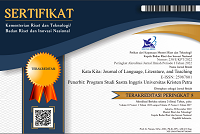Students’ Strategies in Translating Humorous Text
(1) Petra Christian University
(*) Corresponding Author
Abstract
This study aims to find out the problems that students experienced and strategies that students used in translating humorous text. The writer conducted this study using the theory of translation problems and strategies by Baker (2018). This writer conducted this study using a qualitative approach in which she collected and analyzed the data herself. The findings of this study support Baker’s (2018) statement that some of the problems that may appear during translation process are culture-specific concept, the source language concept is not lexicalized in the target language, the source and target language make different distinction in meaning, the target language lacks a specific term (hyponym), differences in expressive meaning, and differences in frequency and purpose of using specific forms. In addition, Text in the source language is translated in several different strategies namely translation by more general word, translation by more neutral or less expressive word, translation by paraphrase using related words, translation by paraphrase using unrelated words, translation using a loan word or loan word plus explanation, and translation by omission. More studies involving other types of humor and other translation theories are recommended to create variations in this field.
Keywords
Full Text:
PDFReferences
Attardo, S. (2020). Pragmatics of humor. In The linguistics of humor: An introduction. Oxford Academic. https://academic.oup.com/book/41037/chapter-abstract/349334930?redirectedFrom=fulltext
Baker, M. (2018). In other words a coursebook on translation (3rd ed.). Routledge. https://www.routledge.com/In-Other-Words-A-Coursebook-on-Translation/Baker/p/book/9781138666887
Bornstein, Marc H., Justin Jager, and Diane L. Putnick. “Sampling in Developmental Science: Situations, Shortcomings, Solutions, and Tandards.” Developmental Review: DR 33, no. 4 (December 2013): 357–70. https://doi.org/10.1016/j.dr.2013.08.003.
Coban, F. (2015). Analysis and training of the required abilities and skills in translation in the light of translation models and general theories of translation studies. Procedia Social and Behavioral Sciences. https://doi.org/10.1016/j.sbspro.2015.07.074
Fitriyani, N. A. (2010). The strategies dealing with problems of non-equivalence at word level found in the translation of Stephenie Meyer’s novel “Twilight” [Undergraduate thesis, Semarang State University]. UNNES Repository. http://lib.unnes.ac.id/597/
International Institute of Climate and Society. “Data Homogeneity.” International Institute of Climate and Society. Accessed July 12, 2022. http://iridl.ldeo.columbia.edu/dochelp/StatTutorial/Homogeneity/index.html.
Karstensen, R. (2018). Hah! The history of American humor: Part 1. https://libraries.indiana.edu/hah-history-american-humor-part-1
Köksal, O., & Yürük, N. (2020). The role of translator in intercultural communication. IJCI International Journal of Curriculum and Instruction, 12(1). https://eric.ed.gov/?id=EJ1249472
Lutviana, R., & Mafulah, S. (2017). Preserving humorous effects in a target language: Challenges in translating culturally loaded expressions. Jurnal Pendidikan Humaniora, 5(4). http://journal.um.ac.id/index.php/jph/article/view/10274
Miñano, G. (2015, November 3). What’s the difference between a CAT-Scan and a CT-Scan? Cincinnati Children’s Blog. https://blog.cincinnatichildrens.org/radiology/whats-the-difference-between-a-cat-scan-and-a-ct-scan/
Mitra, K. (2021). CT scan. 3(1). https://jumr.co.in/index.php/main/article/view/19
Purina. (n.d.). Cat breeds by fur type. Retrieved November 30, 2022, from https://www.purina.co.nz/find-a-pet/articles/cat-types/fur-type/tabby-cats
Romero, E. J., & Pearson, T. R. (2004). The relationship between humor and group productivity an exploratory study. Indian Journals.Com, 4(1). https://www.indianjournals.com/ijor.aspx?target=ijor:jmr&volume=4&issue=1&article=005
Schmitz, J. R. (2002). Humor as a pedagogical tool in foreign language and translation courses. https://www.degruyter.com/document/doi/10.1515/humr.2002.007/html?lang=de
Widiyanto. “Translation Strategies of Non-Equivalence at Word Level in Moris and Hartog van Banda Comic Lucky Luke Ghost Hunt [Undergraduate Thesis, Universitas Dian Nuswantoro].” UDiNus Repository, 2014. http://eprints.dinus.ac.id/5901/.
DOI: https://doi.org/10.9744/katakita.11.1.77-89
Refbacks
- There are currently no refbacks.
Supported by:
Indexed in:
Tools:
Stats (installed since 17 December 2018)
View My Stats













